Think iconic climbs and France’s Alpe d’Huez is, ahem, right up there. Think iconic bike brands, French marques in particular, and Look deserves a well-earned place in anyone’s shortlist. The two seem natural bedfellows, destined to go together as deliciously as croissants et confiture, croustade et pommes and, hmm, Time and Alpe d’Huez. More on that last one later.
Huez, a commune in the French Western Alps, is home to the legendary Alpe d’Huez climb as well as the ski resort where, in 1960, Look founder Jean Beyl, after breaking a leg on the slopes, dreamt up an innovative ski binding that subsequently inspired the brand’s pioneering clipless pedal design. The association between Look and Alpe d’Huez was further cemented when Greg LeMond won a crucial stage of the 1986 Tour de France on the climb, riding the revolutionary KG 86 frame, arguably the first to incorporate carbon fibre tubes successfully.
The Look 785 is an elegantly proportioned bike – style and substance in equal measure.
(Image credit: Simon Fellows)
The Huez model has been a fixture in Look’s lineup for almost a decade now, but the latest iteration, launched last spring, brings the model bang up to date with a T47 85.5mm bottom bracket, full hose/cable integration and clearance for 32mm tyres. Predictably, Look promotes its Huez model as a performance-oriented climber’s bike, but I believe that, by pigeonholing it as such, the brand is underselling it. The Huez is considerably more versatile than that.
This review differs from most you’ll read in Cycling Weekly because I rode the bike for just thirteen days rather than several months. However, during my brief time with the Huez, it carried me almost 1,000 miles across France, from the soft, green, rolling pasturelands of Brittany to the rocky, sun-bleached gorges of Provence. I have never tested a bike so thoroughly.
Construction
The performance bike market is seemingly in flux right now, with some brands maintaining the ‘one bike to do it all’ trend, while others are enthusiastically re-introducing dedicated aero bikes. The Trek Madone Gen 8 and the Colnago Y1RS exemplify these two distinct approaches. And purposeful climbing bikes? Currently, there is no shortage of excellent examples, including the Wilier Verticale, Specialized Aethos, Cannondale SuperSix EVO and Orbea Orca. So, is this the space in which the Look Huez sits?
Look positions the Huez a step down, in terms of performance and price, from its 795 Blade race bike, and a step up from the less expensive 765, which it labels an endurance bike. So, in theory, at least, Look has most bases covered – race, climb and endurance.

Huez by name, versatile by nature. The 785 is more than just a climbing bike.
(Image credit: Simon Fellows)
I was keen to ride a French bike for my trip, so I was delighted when Look kindly obliged with a 785 Huez Pro Team Edition in Satin Black. My colleague Joe Baker waxed lyrical about the 795 race bike, but from his description, I knew it was too hardcore for me to ride all the way across France. Similarly, I was worried that the 765 would be a little too slack and unresponsive once I reached the imposing ascents and descents of the Massif Central. The 785 Huez appeared to hit the sweet spot. Neither too much, nor too little, but just right.
The question was, could a climbing bike go the distance? Or, more accurately, could I manage the distance on a climbing bike?
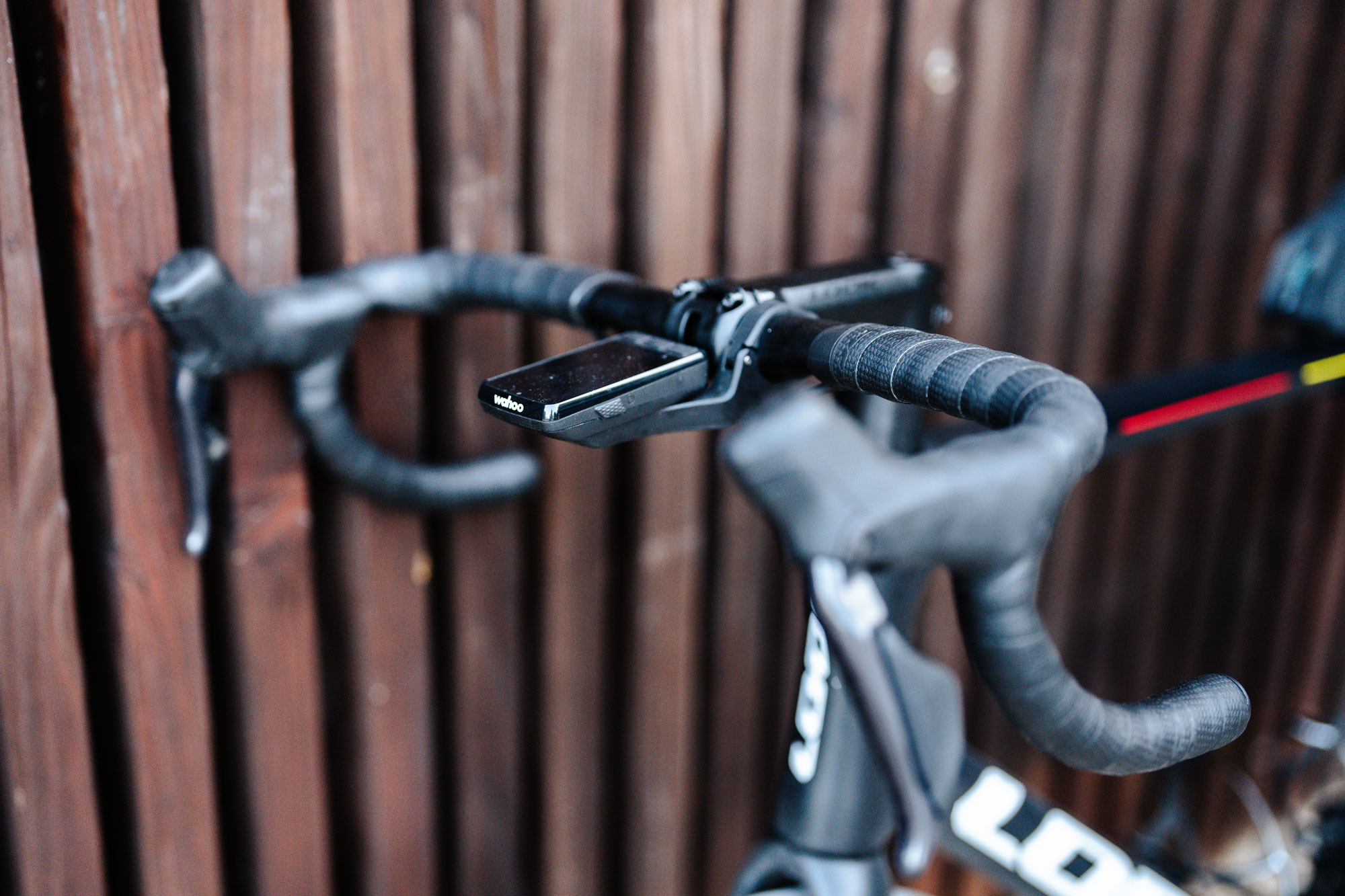
The fully integrated cockpit is perfectly serviceable and very comfortable, but it’s possibly the most pedestrian part of the bike.
(Image credit: Xavier Veyron/Future)
The Huez has the geo typical of a modern climbing bike. Well, pretty much. The head tube angle, reach, and chainstay length – at 73°, 395mm, and 410mm, respectively – are all within a smidgen of the aforementioned Verticale, Aethos, and Orca in a size 56/L. In fact, the Huez has a steeper seat tube angle than any of those bikes, which should, in theory, enable a rider to transfer power more effectively when climbing.
More notably, the difference in stack height is a full 18mm taller than the Look 795, 26mm taller than the Aethos, and a remarkable 32mm taller than the Verticale. I must caveat these figures by noting that sizing can vary considerably across brands, so take them with a pinch of salt. Nonetheless, they suggest that the Huez is less aggressive than its rivals, serving as a climber’s bike that has the potential to take on long rides in some comfort. A trail figure of 59.3mm hints at handling that’s on the stable side of racy too.
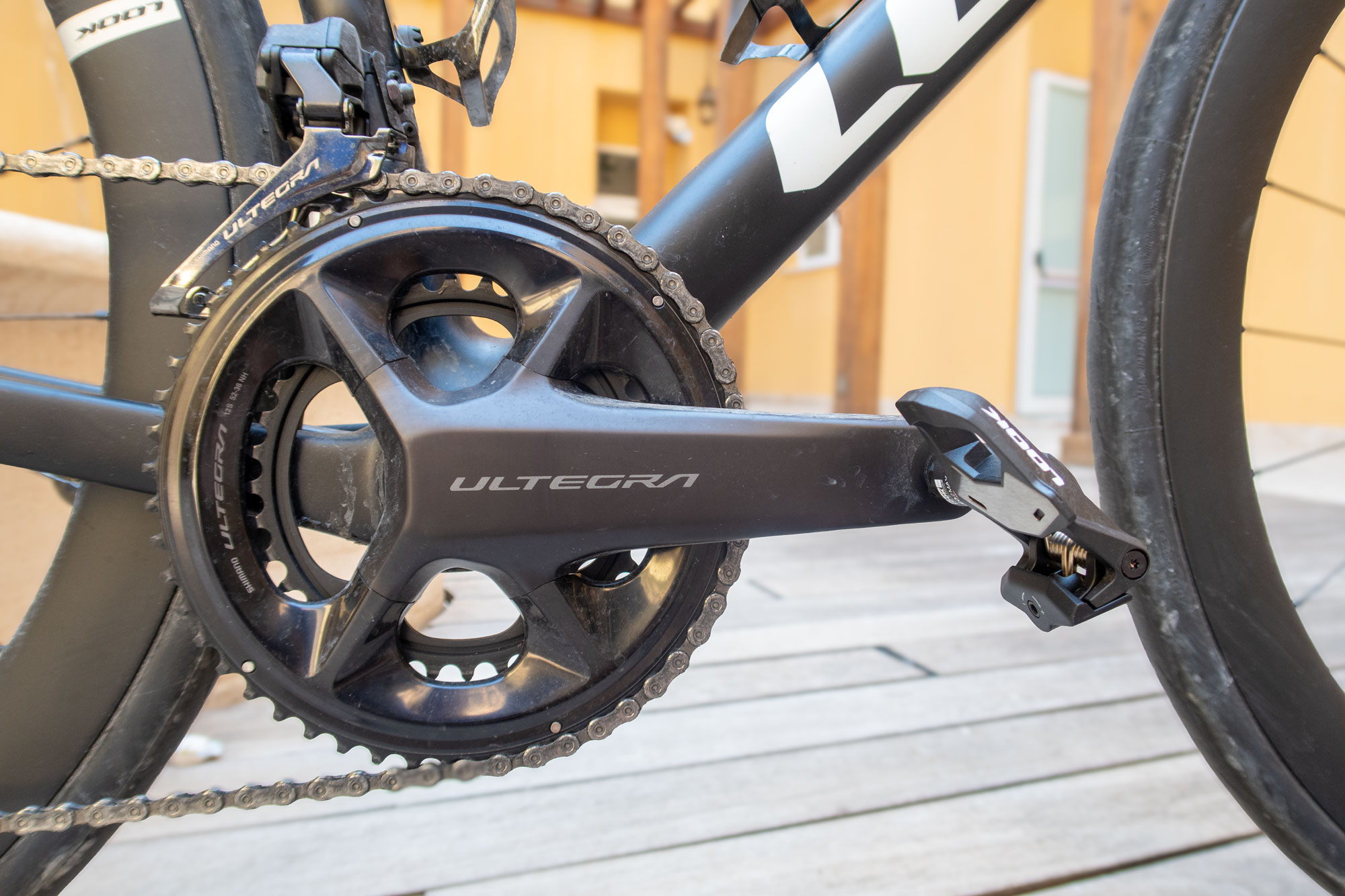
The Pro Team version is equipped with 12-speed Shimano Ultegra.
(Image credit: Simon Fellows)
Look is a little tight-lipped about the grades of carbon fibre used to build a Huez frame. The brand does say it uses ‘high-modulus fibres and minimalist Nano tubes’, which essentially means that the tubes are crafted to have exceptionally thin, light walls wherever strength isn’t a primary requirement. Layup is custom across the different frame sizes to compensate for tube length (longer tubes flex more easily, shorter tubes are less compliant), which should mean that, whatever your height and preferred fit, the same ride feel should be preserved across the board.
Claimed frame weight (size M) is 980g for the frame and 390g for the fork, which is respectable but far from class-leading for a climbing bike. To bring some context, Wilier claims a Verticale frame can weigh a gravity-defying 648g, while Specialized says an S-Works Aethos barely tips the scales at 585g.
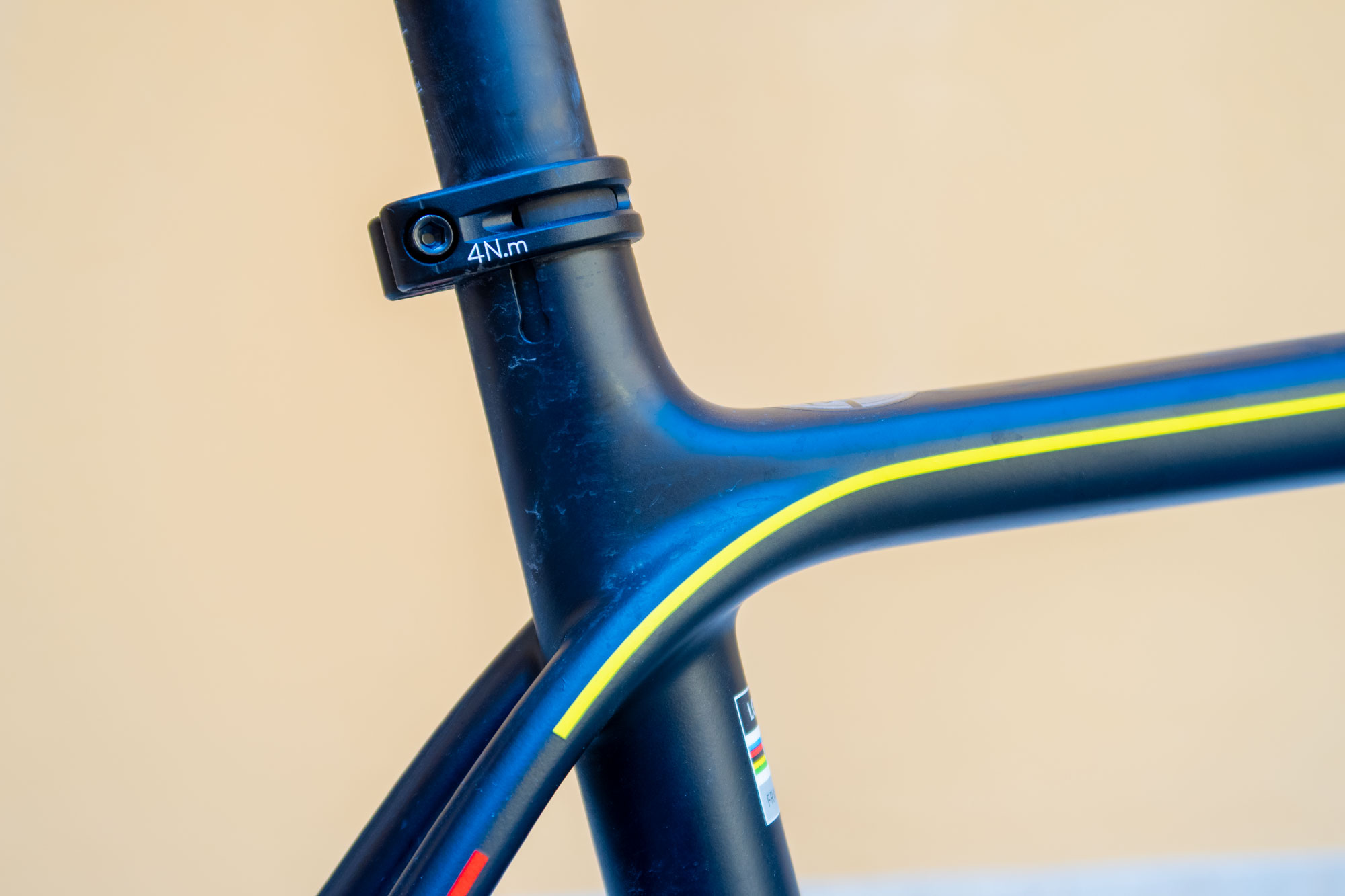
The way the seat stays merge into the top tube is so graceful. The seat post clamp may not be as aesthetically pleasing, but it is practical.
(Image credit: Simon Fellows)
Aesthetically, the frame has a refined, almost timeless quality. The use of predominantly round tube shapes – there are few obvious aero touches here – gives it an uncomplicated, well-balanced appearance that’s both cohesive and harmonious. It’s not a brave, futuristic design like, for example, the Colnago Y1RS, but it’s striking in its sleek simplicity – a frame that confidently whispers, rather than shouts, speed.
Part of that svelte, visual appeal owes a debt to the fully integrated cables and hoses, which are new for this iteration of the bike. The bottom bracket has been updated too, it’s now a beefier, more durable threaded T47 85.5mm standard, and tyre clearance has been upped to 32mm. Despite this, most Huez variants ship with 25mm rubber, so I requested 28mm tyres as a minimum for my ride.
The cockpit on my Pro Team Edition bike featured a comfortable, if unremarkable, combination of a Look LS3 alloy stem (120mm on my XL bike) and Look LS3 alloy bars (440mm on my XL bike). The compact bars have a subtly aero flat profile to the tops.
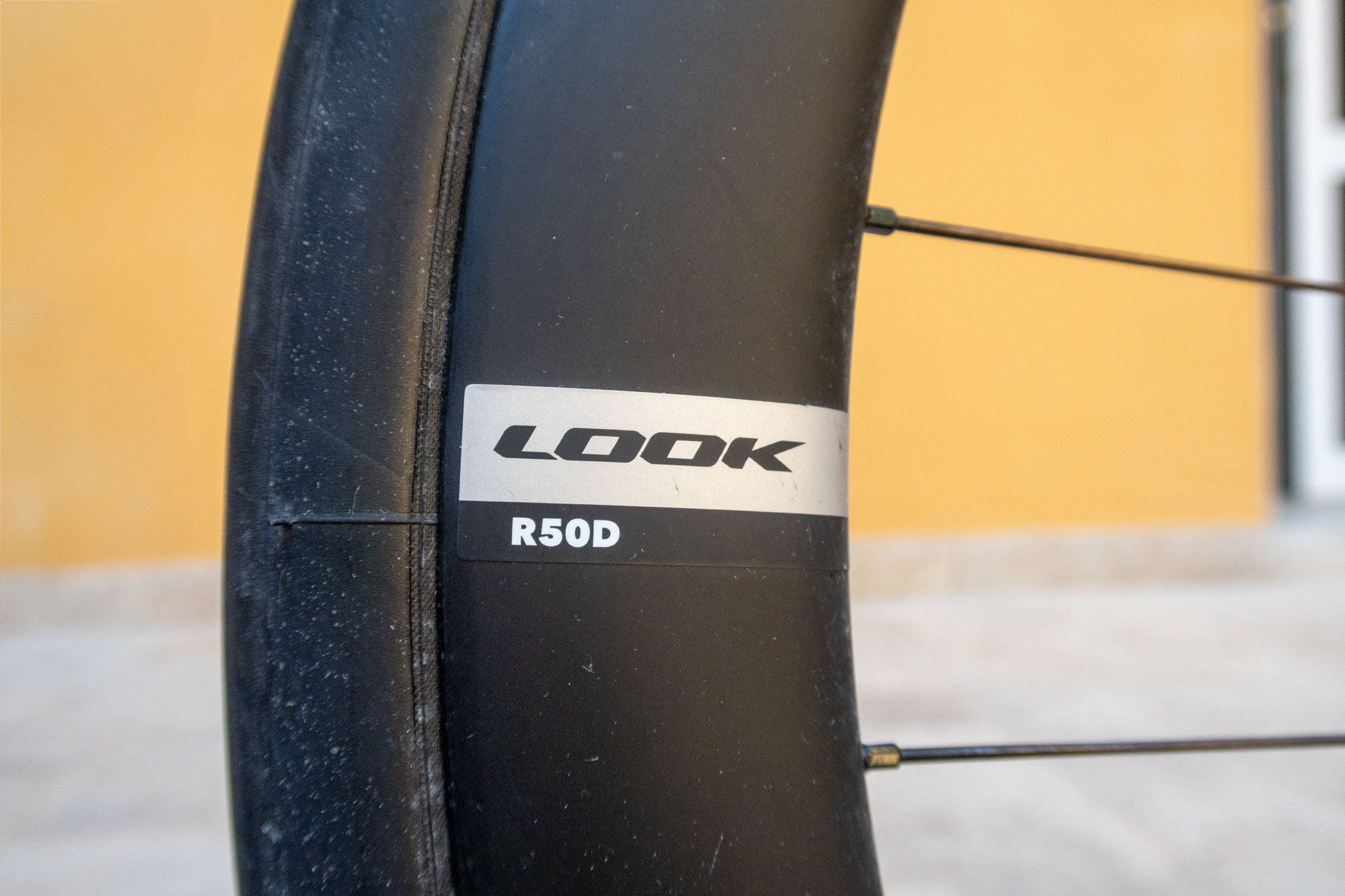
My review bike was fitted with R50D wheels as an option. More aero, but heavier too.
(Image credit: Simon Fellows)
Look equips the Huez Pro Team Edition with Shimano 12-speed Ultegra Di2, which, in my case, behaved faultlessly throughout my entire ride across France. It was shifting as efficiently and silently in Nice as it was when I first hopped on the bike in St Malo. Braking performance only improved with the miles too, with plenty of modulation and bite when required. My review bike was fitted, as standard, with a 52/36t semi-compact chainset, matched to a climb-friendly 11t – 34t cassette. Rotors are 160mm up front with a 140mm at the rear.
The seatpost, a 27.2mm Look LS1 Carbon Super Light, is held in place with a traditional clamp, which may look less elegant than a wedge concealed in the seat tube/top tube junction, but is a heck of a lot more graceful to adjust.
Ordinarily, the Huez Pro Team is fitted with Look R38D carbon wheels, but since my journey would take me through long stretches of relatively flat farmland in northern France, Look equipped my bike with more aerodynamic, deeper-section R50D wheels. I just hoped the wattage gains would outweigh any weight penalty.
Tyres on the Huez, currently at least, are Hutchinson Fusion 5 Performance tubeless-ready tyres, a French-made, mid-priced product with a reputation for being a dependable all-rounder. Hutchinson stopped making these tyres last year, replacing them with the more race-focused Blackbird, so I can only assume Look is using up existing stock. As promised, Look fitted the 28mm versions to my bike.
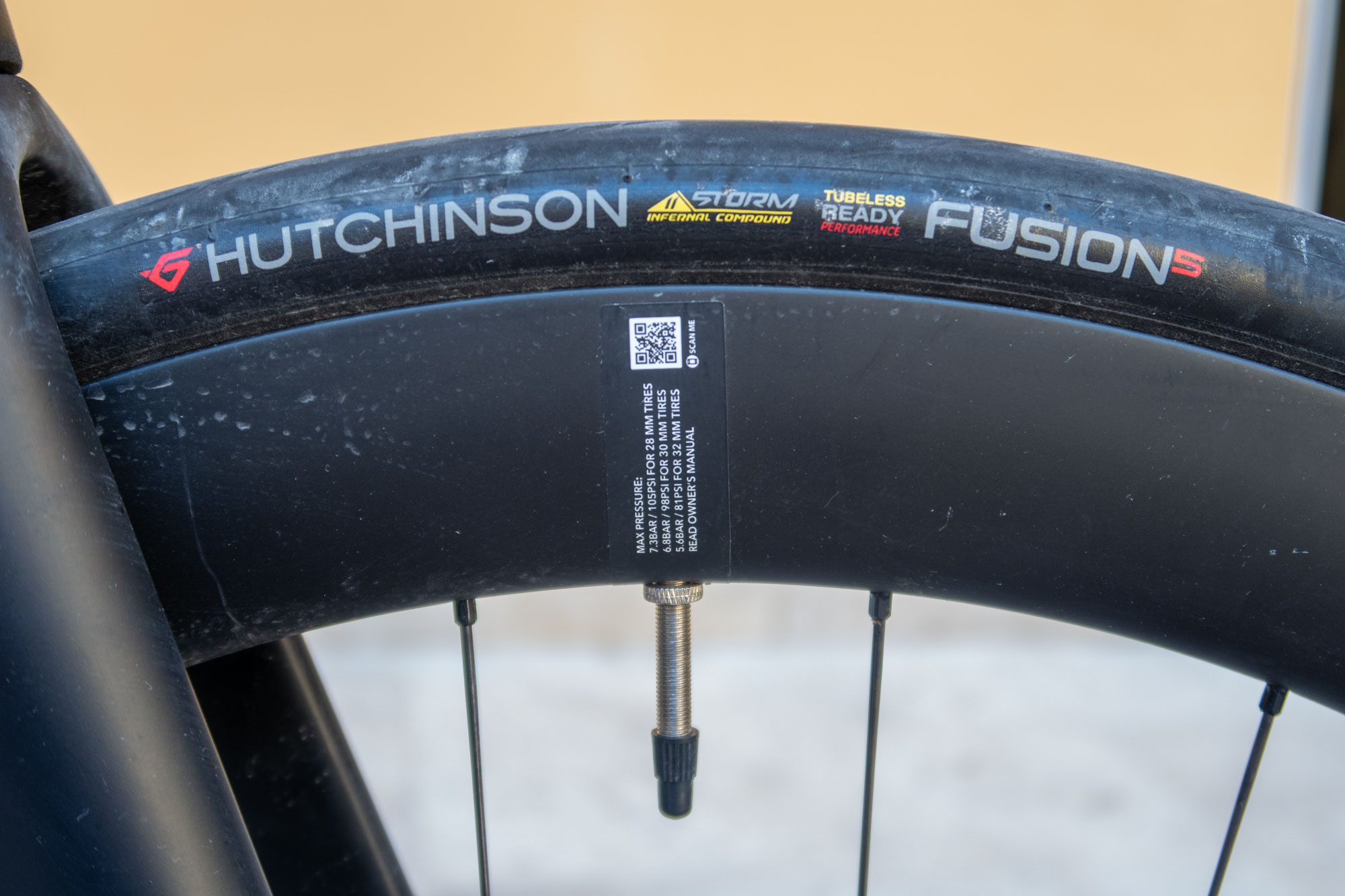
Hutchinson Fusion tyres are fitted by default, but this may not be the case for much longer, as the Blackbird model has superseded them.
(Image credit: Simon Fellows)
The ride
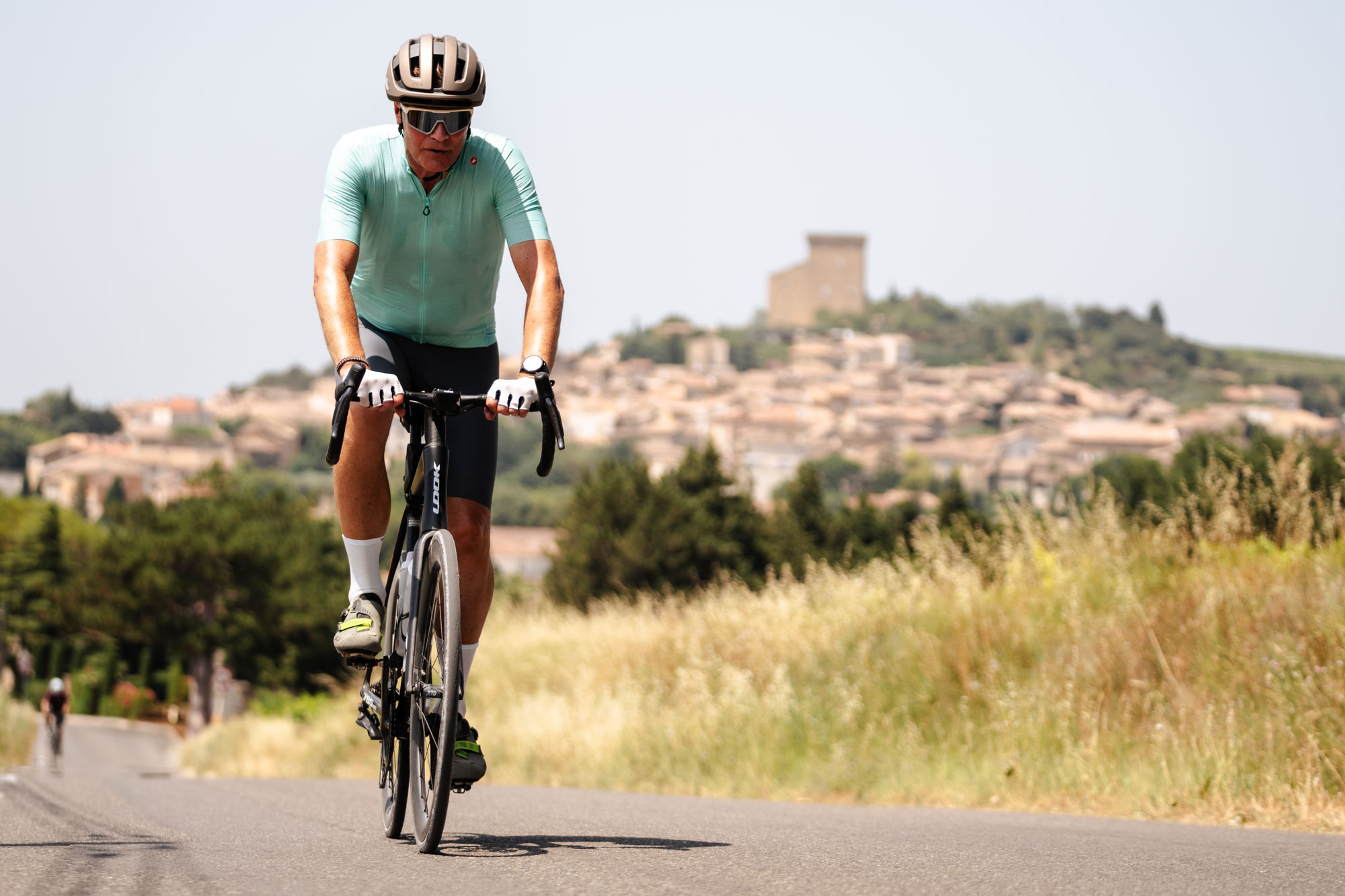
I suffered no discomfort on the Look 785 during my entire ride through France – not one aching joint. I believe the relatively tall stack height played a part here.
(Image credit: Xavier Veyron/Future)
It’s no exaggeration to say that, when I removed the Huez from its cardboard bike box in St Malo, it instantly drew a small crowd. Not just my fellow riding companions, but also our French guides, and even some of the hotel staff, gathered round to cast admiring glances and exchange compliments in rapid-fire French and slow, broken English. It looked drop-dead gorgeous – its stark, matte black paintwork and contrasting bold ‘Look’ logos accentuating the frame’s lean, muscular good looks. My new French friends were utterly bowled over by the Huez, proud to claim such a beautiful object as one of their own.
Picking it up for the first time was, therefore, a slight anti-climax. It’s not a heavy bike by any means but, at the same time, it’s not going to trouble the UCI weight limit, nor a well-equipped Aethos or Verticale. I didn’t have access to bike scales in France, but if I had to guess, I’d say it weighed around the 8 kilo mark, not helped, of course, by the deep-section wheelset and large, heavy cassette.
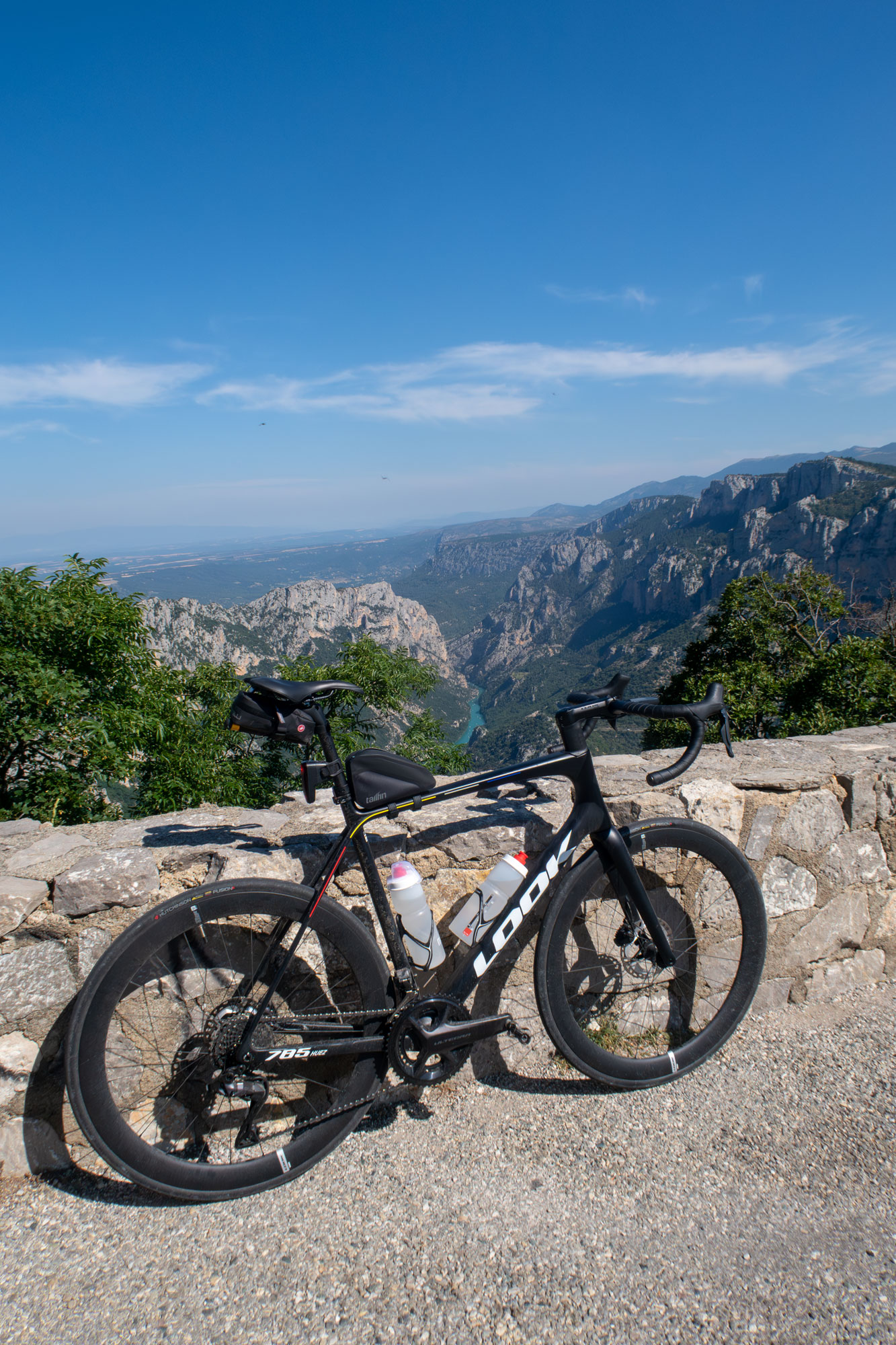
Why we climb – the views from the top…
(Image credit: Simon Fellows)
France may be a country infamous for harrowing ascents, but we encountered none as we rode steadily south through Brittany and Pays de La Loire, two regions as flat as a double serving of sugary-sweet crepes. This did at least give me the chance to become accustomed to the Huez, a two-day opportunity to test its straight-line handling and ride feel.
At a time when it seems that almost every new bike has aero pretensions, regardless of ride discipline – super-deep hourglass-shaped head tubes; blunt, Kamm profile down tubes; dropped stays and so on – how pleasing it is to jump on a performance bike that’s more rider-focused. The Look 785 Huez’s ride character immediately felt like a natural extension of my body; it’s a bike that works with you rather than against you.
The bike’s geo, with its comparatively elevated stack and generous trail figure, suggested an undemanding ride, but I was surprised just how composed the Huez felt. On gently undulating roads, the handling is sublime, with plenty of character but no nervous skittishness threatening to cause trouble around the next bend. We only encountered mild crosswinds, but even with the optional 50mm wheels fitted, the Huez felt resolutely stable.
French roads enjoy a reputation for being smoother than Alain Delon, but the reality is that the surfaces within built-up areas – remote villages in particular – are often as bad as anything in the UK. The Huez soaks up the bumps and lumps well, but extended sections of tar and chip did find me wishing for wider tyres running at lower pressures.
It’s a bike that surges forwards eagerly as soon as you put any power into the pedals, helped, no doubt, by those deep-section wheels that spin up urgently before keeping the momentum going with flywheel-like consistency.
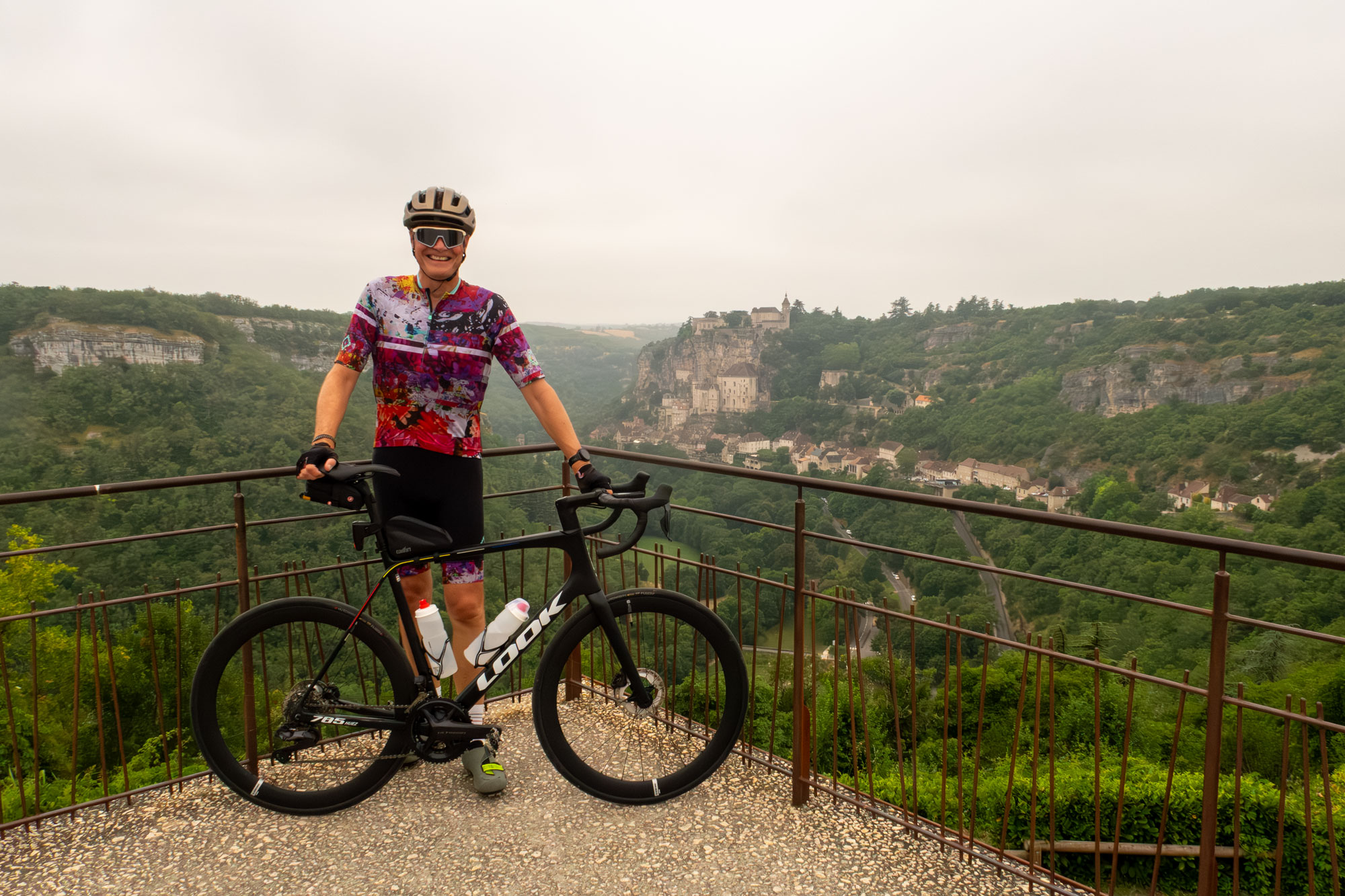
The Look 785 Huez, looking cool after a climb up to Rocamadour. I wish I could say the same about me.
(Image credit: Simon Fellows)
Of course, it’s the frame that’s the star performer here. It may not be the lightest, but Look has done a fine job optimising the layup so that every input – power or handling – is matched by a correspondingly direct output without compromising ride feel or comfort.
Once across the Loire, the hills gradually began to build, a trend that continued inexorably until Nice. Within a few brief days, the charming, short slopes of the Dordogne gave way to the longer, more challenging climbs of the Ardèche, Rhône-Alpes and Provence-Alpes-Côte d’Azur.
The Huez, weighed down by the heavier wheels, large cassette and a pair of 750ml bidons, performed admirably, with the higher stack helping to keep potential back and neck strain in check on the longer climbs. It remained considerably more accomplished than I did, particularly in the afternoons when, day after day, 38°C heat significantly blunted my already modest ability as a climber.
The bike and I were both more spirited on the descents, powering down the straights before attempting to carry as much momentum through the corners as I dared. It’s in these moments that the sensation of ‘oneness’, which I described earlier, paid dividends. As each corner presented itself, and I instinctively leaned the bike as I turned in, I felt a reassuringly high level of grip from the front wheel, enabling me to flow with much excitement, but little drama, from apex to exit and repeat. I’m far from being a world-class descender, but the Huez, bless it, flatters a rider of my ability, helping me to have more fun on the slopes than I probably deserve.
Value and conclusions
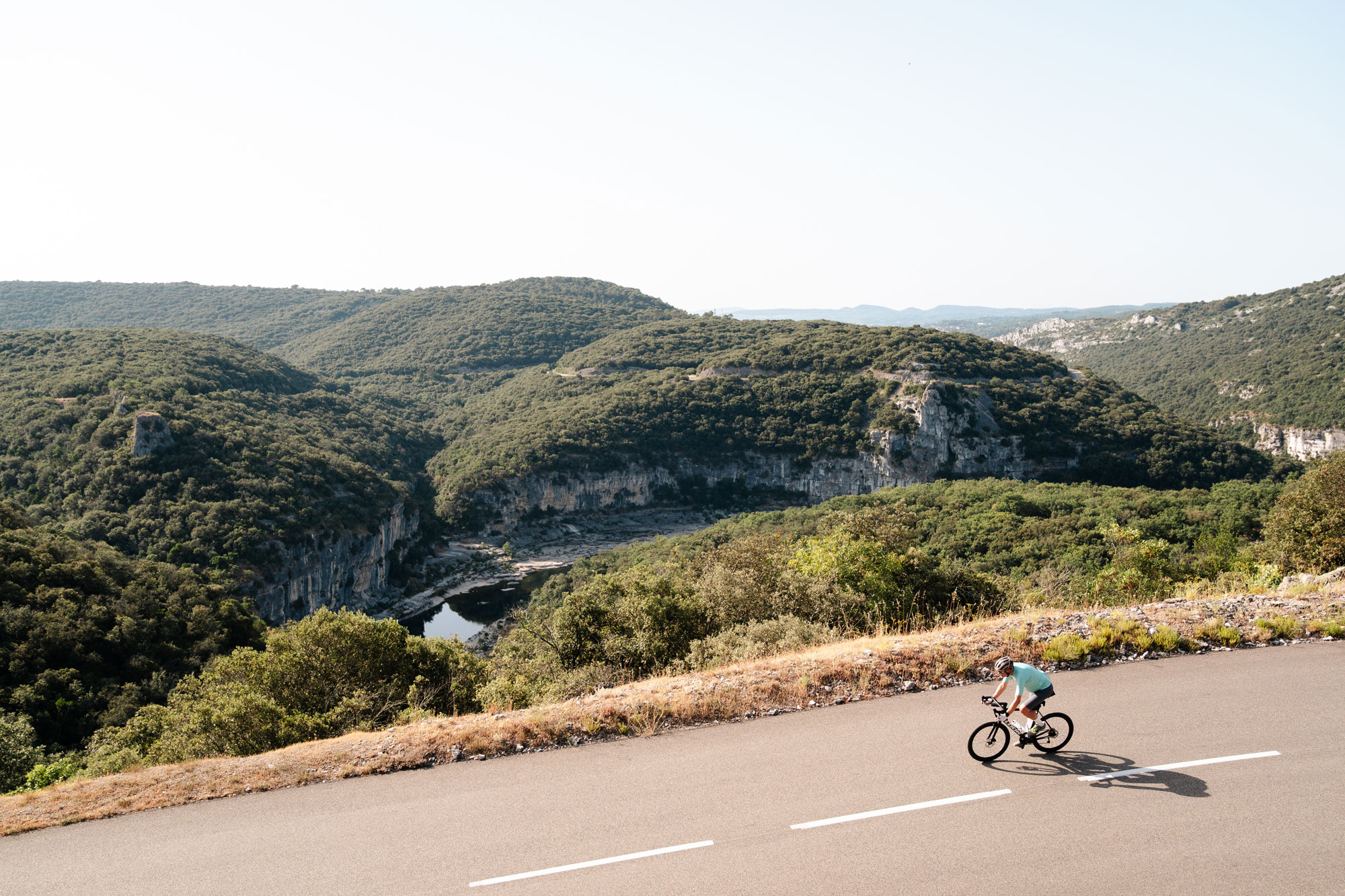
The Look 785 Huez was a joy to ride on smooth, fast, empty French roads.
(Image credit: Xavier Veyron/Future)
The sensible choice for an epic ride across France is an endurance bike. Yet, I’d argue that the Look 785 Huez performed just as well, if not better. Fast, agile and supremely comfortable, it was also great fun, especially on the descents. Over 1,000 miles it didn’t miss a beat and, with its help, nor did I – no back ache, shoulder pain, knee pain, white finger… You name it, I didn’t suffer it.
I did swap out the stock saddle, not just as a preventative measure, but because I wanted to review the recently launched Selle SMP Evo30C, which I found incredibly comfortable. To help me settle into the ride, I rode a Fizik Tempo Argo R3 for the first few days, a saddle I’m very familiar with.
Look enjoys a reputation for making excellent bikes, but that can often mean high prices, so let’s compare the Huez with some similarly specced rivals.
The 785 Huez Pro Team Edition costs £6,200/$6,925, making it a competitive option when compared to other similarly specified Ultegra-equipped climbing bikes, such as the £8,200/$6,999 Specialized Aethos Pro, the £8,250/$9,999 Cannondale SuperSix EVO Hi-MOD 2, and the £9,000/$12,100 Wilier Verticale. The Orbea Orca M20ILTD PWR is slightly cheaper at £5,599/$7,299, as is the Canyon CF SLX 8 Di2 at £5,599/$5,999.
So, although the Huez is a sizeable investment, it sits at the more affordable end of the spectrum.

(Image credit: Simon Fellows)
What about the similarly named Alpe d’Huez from fellow iconic French brand Time? Interestingly, it’s also a climbing bike with traditional (for carbon fibre) tube shapes, which performs equally as well as an endurance bike. Like the Look, the Time’s frame does get criticised for being a little on the heavy side, yet it is praised for its ride quality. Time sells the Alpe d’Huez as a frameset only, which is a touch more expensive than the Look 785’s at £2,749/$3,499 vs £2,490/$2,609. The Time’s tyre clearance is limited to just 28mm, too, which seems a little outdated and will restrict the intended usage for some.
Would I recommend the Look 785 Huez? As a versatile climbing bike, capable of swallowing up long distances in comfort and at speed, then yes, unreservedly. As a die-hard, lightweight climber that only a weight-weenie could love? No, the weight of the frame would always niggle me. However, if it takes a little weight to make a great frame, I’m more than happy with the compromise.
